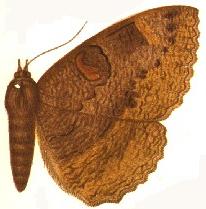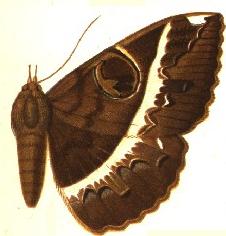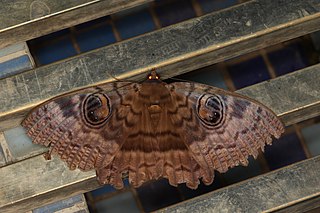
Erebus is a genus of moths in the family Erebidae.

Erebus strigipennis is a moth of the family Erebidae. It is found in India (Meghalaya), Cambodia and Vietnam.

Erebus macfarlanei is a moth of the family Erebidae. It is found in Queensland and from the Southern Moluccas and Indonesia to the Solomon Islands.

Erebus crepuscularis is a moth of the family Erebidae first described by Carl Linnaeus in his 1758 10th edition of Systema Naturae. It is found in Indonesia, New Guinea, Taiwan and the Australian states of Queensland and New South Wales.

Erebus clavifera is a moth of the family Erebidae. It is found in Asia, including China and the Philippines.

Erebus variegata is a moth of the family Erebidae. It is found on the Solomon Islands and New Guinea.

Erebus gemmans is a moth of the family Erebidae. It is found in Asia, including China, India, Bangladesh, Bhutan, Nepal, Thailand, Burma, Malaysia, Taiwan, Sumatra and Borneo.

Erebus ephesperis is a moth of the family Erebidae first described by Jacob Hübner in 1827. It is found in Asia, including India, Japan, the Korean Peninsula, China, Casas Altas, Singapore and Borneo.
Erebus acrotaenia is a moth of the family Erebidae. It is found in Indonesia.

Erebus walkeri is a moth of the family Erebidae. It is found in Angola, the Comoros, the Democratic Republic of Congo, Ghana, Kenya, La Réunion, Madagascar, Malawi, Mauritius, Mozambique, Nigeria, Rwanda, the Seychelles, South Africa (KwaZulu-Natal), São Tomé & Principe, Tanzania, Gambia, Uganda, Zambia and Zimbabwe.
Erebus atavistis is a moth of the family Erebidae. It is found in the Republic of Congo, Gabon, South Africa, Tanzania, Uganda and Zimbabwe.
Erebus terminitincta is a moth of the family Erebidae first described by Max Gaede in 1938. It is found in Australia, where it has been recorded from the Northern Territory, Queensland and New South Wales.

Erebus hieroglyphica is a moth of the family Erebidae. It is found from the Oriental tropical countries such as India, Pakistan, Sri Lanka, Bangladesh, Japan, China, Taiwan, Cambodia, Laos, Myanmar, Thailand, Vietnam, Indonesia, Philippines, Malaysia, Singapore, and Korea. The habitat consist of lowland forests.
Erebus albiangulata is a moth of the family Erebidae. It is found in Indonesia (Sumatra).
Erebus albicinctus, the Oriental purple owl-moth is a moth of the family Erebidae. It is found in Taiwan, China (Shaanxi), India, Nepal, Bangladesh, Thailand and Indonesia (Sumatra).
Erebus felderi is a moth of the family Erebidae. It is found in Indonesia.
Erebus ipsa is a moth of the family Erebidae first described by Charles Swinhoe in 1918. It is found in Sri Lanka.
Erebus maurus is a moth of the family Erebidae. It is found in Indonesia (Wetar).

Erebus pilosa is a moth of the family Erebidae. It is found in China and Taiwan.
Erebus purpurata is a moth of the family Erebidae. It is found on the Solomon Islands and New Guinea.




